The LG G4 Review
by Joshua Ho on July 30, 2015 10:00 AM EST- Posted in
- Smartphones
- Qualcomm
- LG
- Mobile
- Snapdragon 808
- LG G4
System Performance Cont'd
While we’ve seen how the LG G4 performs in some general system workloads, in the interest of focusing a bit more strongly on GPU performance and gaming workloads we’ve also run a suite of benchmarks that are closer to mobile games in terms of workload and more strongly emphasize GPU performance. These tests are usually representative of burst/turbo performance. Those interested in steady-state performance can take a look at our extended rundown tests in the battery life section.
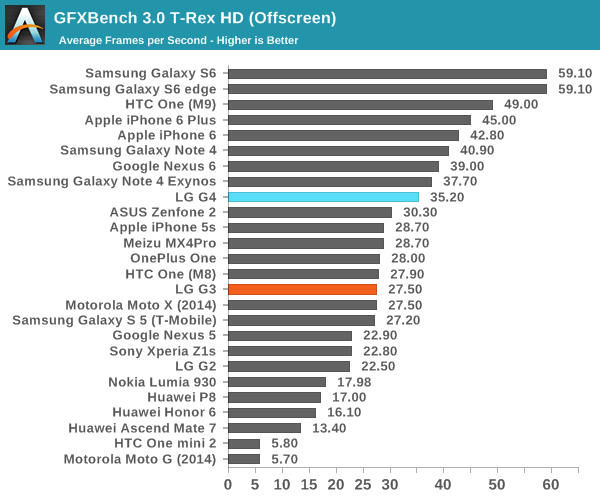
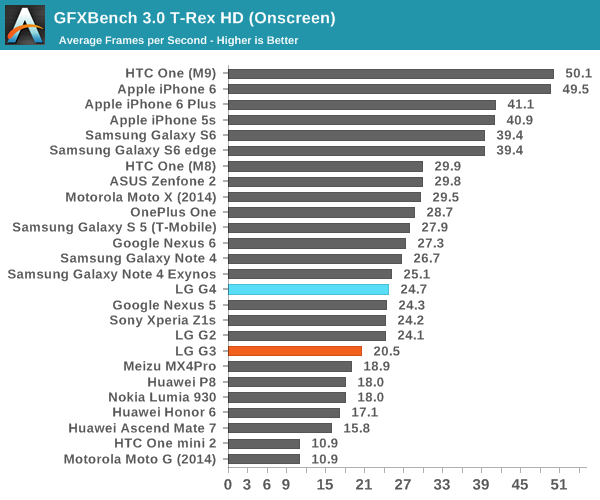
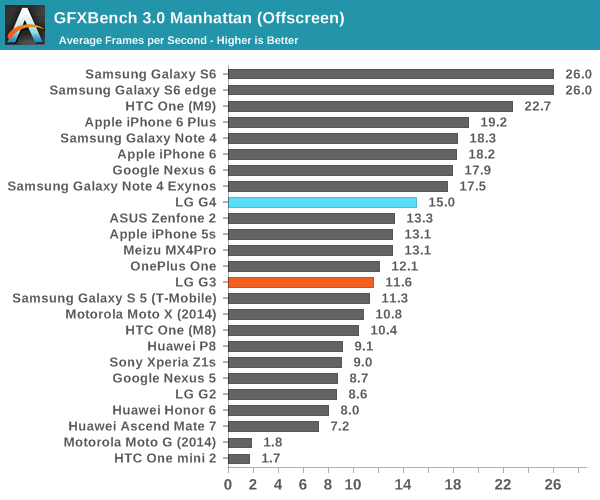
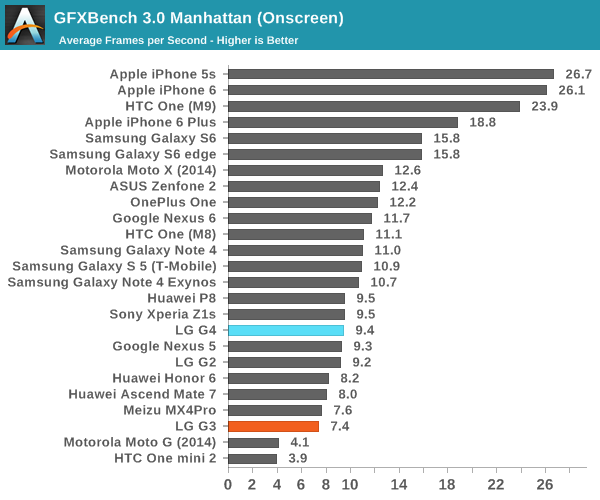
In GFXBench, we can see that the Adreno 418 GPU is a definite step up from the Adreno 330 in the Snapdragon 801, but not quite at the level of the Snapdragon 805's Adreno 420. As a result, on-screen performance is similar to the Snapdragon 800's Adreno 330. This seems to hold in both tests, which suggests that the balance between shader hardware and texturing hardware is relatively similar to the Adreno 330.
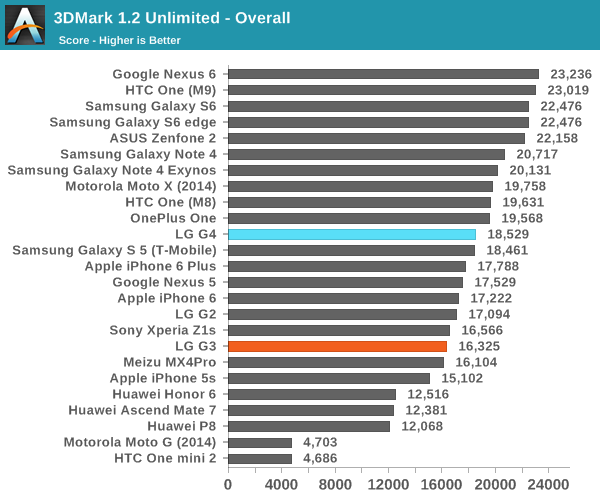
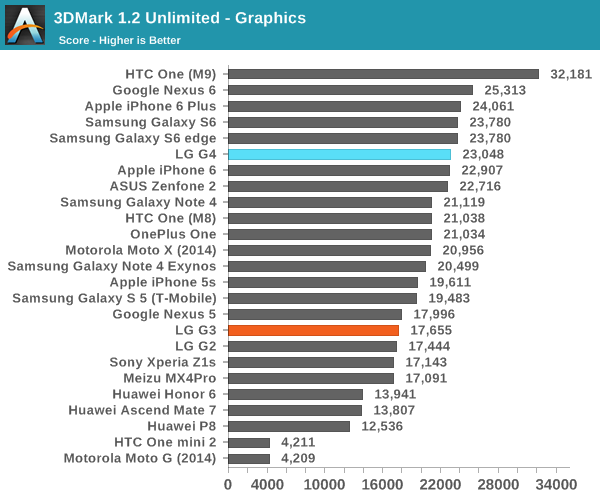
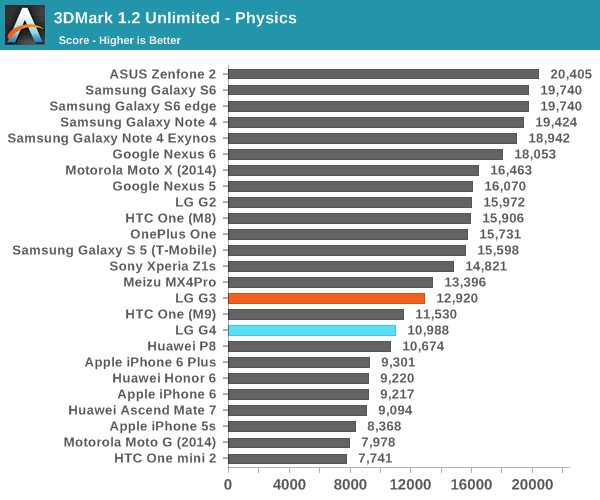
3DMark is a bit of an odd test in the sense that the factors that influence performance in the test are generally hard to predict, but we see a significant deficit in the physics test as it seems to be strongly influenced by main memory latency as the test is cache-unfriendly. The graphics test also indicates a minor improvement over the Snapdragon 801, likely due to differences in architecture from the Adreno 330 to 418 that are coming through in this test. At any rate, the end result is that the G4 ends up around the same level as Snapdragon 801 devices.
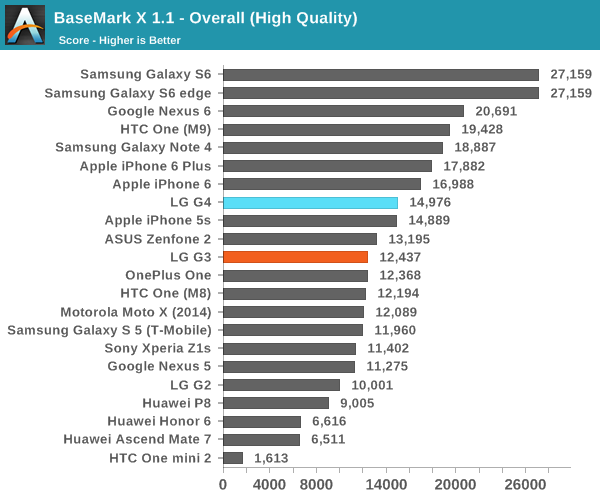
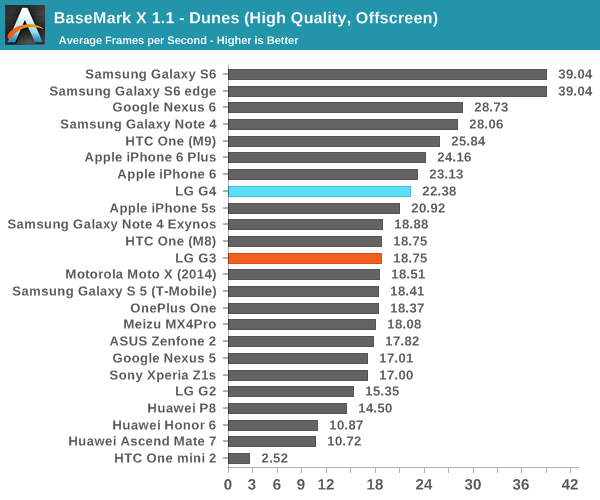
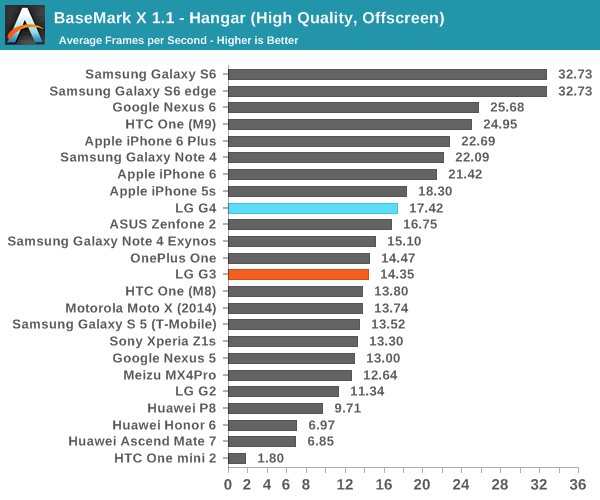

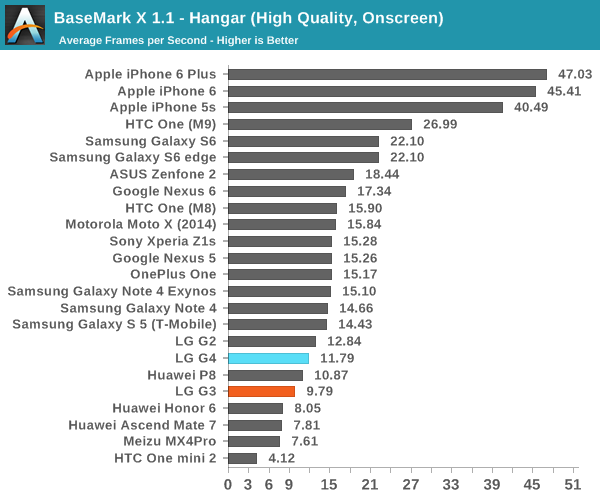
In this test we see that the G4 has a noticeable uplift relative to various Snapdragon 801 devices, but the improvement continues to be slim enough that in on-screen performance the 418 is really comparable to the Adreno 330 in the Snapdragon 800 rather than the Snapdragon 801, which puts it just below the Adreno 420. Overall, the LG G4 is definitely fast enough to enable a good user experience, although the somewhat weaker burst GPU performance leaves it at a handicap relative to anything equipped with an Exynos 7420. Given some of the issues we've seen with the Snapdragon 810, it seems that LG's choice was a wise one.
NAND Performance
Although NAND performance has always been important, until the Nexus 7 (2012) it wasn’t really an area that received a lot of scrutiny. For the most part, people didn’t really pay attention to storage beyond how much storage was available. As a result, this aspect of the device was often subject to aggressive cost control, often to the detriment of performance. However, in the case of the Nexus 7 we really started to see how cutting too far could make a device almost unusable instead of just slow and frustrating.
In the interest of testing this aspect of device performance, we use Androbench with some minor modifications to test settings to get a rough idea for how fast the internal storage solution is. In the case of the LG G4, it seems that Toshiba manufactures this NAND, named 032G74, but there’s otherwise not much information publicly available on this eMMC solution.
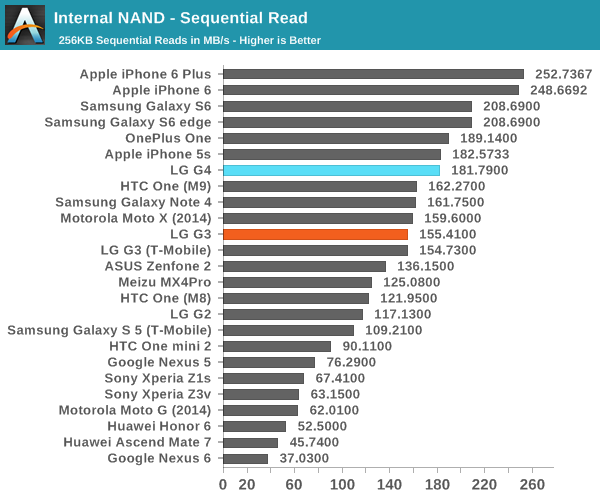
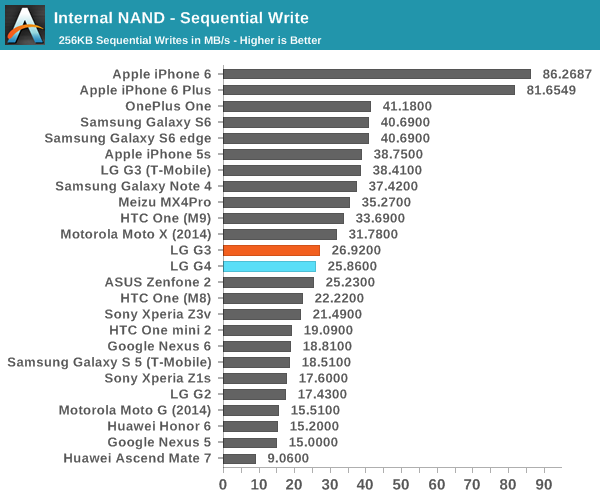
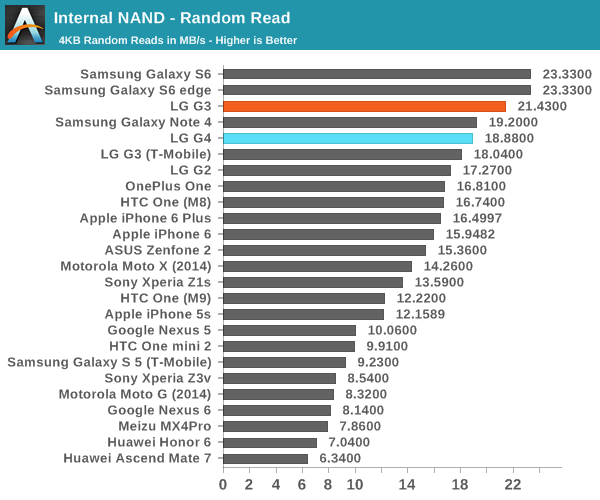
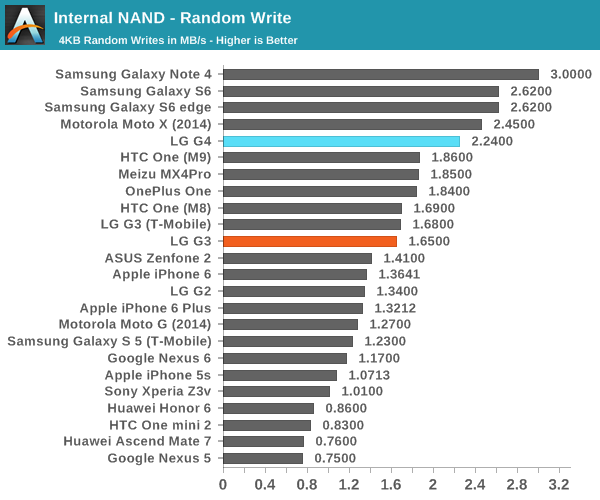
As far as I can tell, the LG G4 has relatively similar NAND performance relative to the G3, but the tuning appears to be somewhat different as the G3 is faster in random reads but the G4 is faster in random writes. Either way, the storage solution in the G4 is sufficient for good performance, although not quite as fast as the Galaxy S6. I suspect that in the absence of an SLC caching system similar to the variant of iPhone 6 that we tested that sequential reads/writes will continue to be relatively low.










84 Comments
View All Comments
hans_ober - Thursday, July 30, 2015 - link
Hoping the Moto G review comes out in the next 2 days!Flunk - Thursday, July 30, 2015 - link
It's a shame this doesn't have a 5" 1080p display, then it would be perfect.hans_ober - Thursday, July 30, 2015 - link
Yeah, 720p is fine, but 1080p is a noticeable improvement. Stuff is visibly sharper.Bigger battery + Better GPU would have also been needed to maintain parity.
jjj - Thursday, July 30, 2015 - link
Funny how the tone changes with the manufacturer instead of being proportional with the numbers.But even more amazing is that everybody when talking iphone camera fully ignores the resolution. The thing has 2-3 times fewer pixels that the "nermal"high res phone cams. No matter the methodology of factoring in the res , the iphone still starts with at least a 20-30% handicap in the final grade. But almost everybody just ignores the res, like it's not there at all. Granted,that's the norm for any iphone flaw or missing feature.
Anyway, hope you guys stop being so lazy, get rid of every SoC banchmark you are using now and replace them with something useful.
boostern - Thursday, July 30, 2015 - link
There are other websites that already do that. We are here reading Anandtech because we like "every SoC benchmark", for us it is useful.hans_ober - Thursday, July 30, 2015 - link
Yeah, many websites give you a tldr, which appeals to a normal user: "the phone is fast blah blah"Then you have other websites that post benchmarks and stuff for "tech guys" : "octa core.. 1080p blah "
Aand then there's Anandtech. Don't get me started on their deep-dives.
Impulses - Thursday, July 30, 2015 - link
Hmm, if it were something like 12mp vs 16mp+ I'd say it'd be fair to downplay res, but 8 vs 16 and beyond really does make a big difference when it comes to printing or even cropping for tighter framing online.Nerdy Geek - Thursday, July 30, 2015 - link
I am surprised that you say the LG G4 and jesusPhone+ have a better camera. Both DPreview and DXO mark says otherwise by a large margin for the S6 (except perhaps in manual mode on the G4 in low light). From my short time with a S6 Edge I would agree (also had 6 and 6+ for about 2 weeks)grayson_carr - Thursday, July 30, 2015 - link
I'm surprised too. I used the Galaxy S6 for 2 months and the G4 for 1 month and did several side by side camera comparisons. I thought the Galaxy S6 had a better auto mode and took better pictures in good lighting, and the G4 had a superior manual mode and took better pictures in low light. In auto mode in daylight, I found that the G4 was too hesitant to use HDR, probably because it is rather slow compared to the real time HDR on the S6. And the G4 often produced either overly soft or overly sharpened photos.phoenix_rizzen - Thursday, July 30, 2015 - link
Took them a couple years and several phone iterations, but it looks like they may have finally come out with an upgrade for the LG G2.